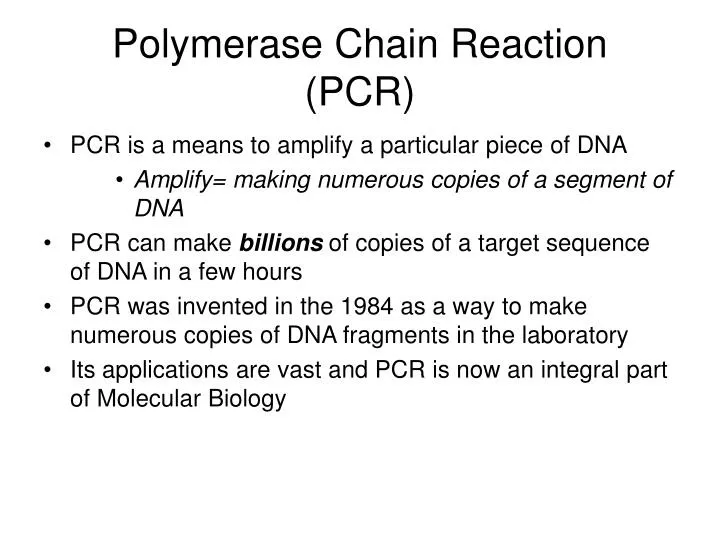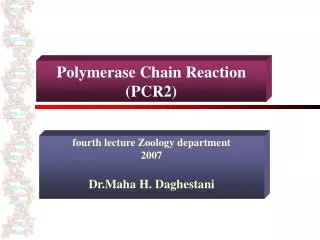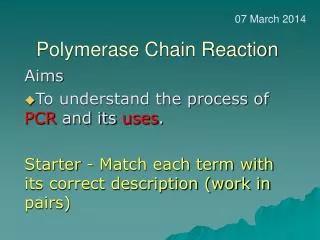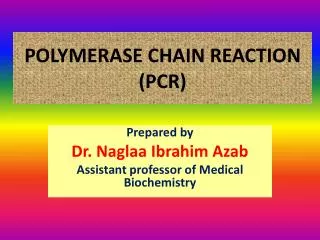

Polymerase Chain Reaction (PCR)
Apr 05, 2013
400 likes | 1.21k Views
Polymerase Chain Reaction (PCR). PCR is a means to amplify a particular piece of DNA Amplify= making numerous copies of a segment of DNA PCR can make billions of copies of a target sequence of DNA in a few hours
Share Presentation
- parallel dna strands
- previous cycle
- complementary sequences
- new dna strands
- denature dna

Presentation Transcript
Polymerase Chain Reaction(PCR) • PCR is a means to amplify a particular piece of DNA • Amplify= making numerous copies of a segment of DNA • PCR can make billions of copies of a target sequence of DNA in a few hours • PCR was invented in the 1984 as a way to make numerous copies of DNA fragments in the laboratory • Its applications are vast and PCR is now an integral part of Molecular Biology
DNA Replication vs. PCR • PCR is a laboratory version of DNA Replication in cells • The laboratory version is commonly called “in vitro” since it occurs in a test tube while “in vivo” signifies occurring in a living cell.
DNA replication is the copying of DNA It typically takes a cell just a few hours to copy all of its DNA DNA replication is semi-conservative (i.e. one strand of the DNA is used as the template for the growth of a new DNA strand) This process occurs with very few errors (on average there is one error per 1 billion nucleotides copied) More than a dozen enzymes and proteins participate in DNA replication DNA Replication in Cells (in vivo)
Key enzymes involved in DNA Replication • DNA Polymerase • DNA Ligase • Primase • Helicase • Topoisomerase • Single strand binding protein
DNA Replication enzymes: DNA Polyerase • catalyzes the elongation of DNA by adding nucleoside triphosphates to the 3’ end of the growing strand • A nucleotide triphosphate is a 1 sugar + 1 base + 3 phosphates • When a nucleoside triphosphate joins the DNA strand, two phosphates are removed. • DNA polymerase can only add nucleotides to 3’ end of growing strand
Complementary Base-Pairing in DNA • DNA is a double helix, made up of nucleotides, with a sugar-phosphate backbone on the outside of the helix. • Note: a nucleotide is a sugar + phosphate + nitrogenous base • The two strands of DNA are held together by pairs of nitrogenous bases that are attached to each other via hydrogen bonds. • The nitrogenous base adenine will only pair with thymine • The nitrogenous base guanine will only pair with cytosine • During replication, once the DNA strands are separated, DNA polymerase uses each strand as a template to synthesize new strands of DNA with the precise, complementary order of nucleotides.
DNA Replication enzymes: DNA Ligase • The two strands of DNA in a double helix are antiparallel (i.e. they are oriented in opposite directions with one strand oriented from 5’ to 3’ and the other strand oriented from 3’ to 5’ • 5’ and 3’ refer to the numbers assigned to the carbons in the 5 carbon sugar • Given the antiparallel nature of DNA and the fact that DNA ploymerases can only add nucleotides to the 3’ end, one strand (referred to as the leading strand) of DNA is synthesized continuously and the other strand (referred to as the lagging strand) in synthesized in fragments (called Okazaki fragments) that are joined together by DNA ligase.
DNA Replication enzymes: Primase • DNA Polymerase cannot initiate the synthesis of DNA • Remember that DNA polymerase can only add nucleotides to 3’ end of an already existing strand of DNA • In humans, primase is the enzyme that can start an RNA chain from scratch and it creates a primer (a short stretch RNA with an available 3’ end) that DNA polymerase can add nucleotides to during replication. Note that the RNA primer is subsequently replaced with DNA
DNA Replication enzymes:Helicase, Topoisomerase and Single-strand binding protein • Helicase untwists the two parallel DNA strands • Topoisomerase relieves the stress of this twisting • Single-strand binding protein binds to and stabilizes the unpaired DNA strands
PCR: the in vitro version of DNA Replication The following components are needed to perform PCR in the laboratory: • DNA (your DNA of interest that contains the target sequence you wish to copy) • A heat-stable DNA Polymerase (like Taq Polymerase) • All four nucleotide triphosphates • Buffers • Two short, single-stranded DNA molecules that serve as primers • Thin walled tubes • Thermal cycler (a device that can change temperatures dramatically in a very short period of time)
PCR The DNA, DNA polymerase, buffer, nucleoside triphosphates, and primers are placed in a thin-walled tube and then these tubes are placed in the PCR thermal cycler PCR Thermocycler
The three main steps of PCR • The basis of PCR is temperature changes and the effect that these temperature changes have on the DNA. • In a PCR reaction, the following series of steps is repeated 20-40 times (note: 25 cycles usually takes about 2 hours and amplifies the DNA fragment of interest 100,000 fold) Step 1: Denature DNA At 95C, the DNA is denatured (i.e. the two strands are separated) Step 2: Primers Anneal At 40C- 65C, the primers anneal (or bind to) their complementary sequences on the single strands of DNA Step 3: DNA polymerase Extends the DNA chain At 72C, DNA Polymerase extends the DNA chain by adding nucleotides to the 3’ ends of the primers.
Heat-stable DNA Polymerase • Given that PCR involves very high temperatures, it is imperative that a heat-stable DNA polymerase be used in the reaction. • Most DNA polymerases would denature (and thus not function properly) at the high temperatures of PCR. • Taq DNA polymerase was purified from the hot springs bacterium Thermus aquaticus in 1976 • Taq has maximal enzymatic activity at 75 C to 80 C, and substantially reduced activities at lower temperatures.
Denaturation of DNA This occurs at 95 ºC mimicking the function of helicase in the cell.
Step 2 Annealing or Primers Binding Reverse Primer Forward Primer Primers bind to the complimentary sequence on the target DNA. Primers are chosen such that one is complimentary to the one strand at one end of the target sequence and that the other is complimentary to the other strand at the other end of the target sequence.
Step 3 Extension or Primer Extension extension extension DNA polymerase catalyzes the extension of the strand in the 5-3 direction, starting at the primers, attaching the appropriate nucleotide (A-T, C-G)
The next cycle will begin by denaturing the new DNA strands formed in the previous cycle
The Size of the DNA Fragment Produced in PCR is Dependent on the Primers • The PCR reaction will amplify the DNA section between the two primers. • If the DNA sequence is known, primers can be developed to amplify any piece of an organism’s DNA. Forward primer Reverse primer Size of fragment that is amplified
The DNA of interest is amplified by a power of 2 for each PCR cycle For example, if you subject your DNA of interest to 5 cycles of PCR, you will end up with 25 (or 64) copies of DNA. Similarly, if you subject your DNA of interest to 40 cycles of PCR, you will end up with 240 (or ) copies of DNA!
PCR has become a very powerful tool in molecular biology • One can start with a single sperm cell or stand of hair and amplify the DNA sufficiently to allow for DNA analysis and a distinctive band on an agarose gel. • One can amplify fragments of interest in an organism’s DNA by choosing the right primers. • One can use the selectivity of the primers to identify the likelihood of an individual carrying a particular allele of a gene.
More about Primers • PCR primers are short, single stranded DNA molecules (15-40 bp) • They are manufactured commercially and can be ordered to match any DNA sequence • Primers are sequence specific, they will bind to a particular sequence in a genome • As you design primers with a longer length (15 → 40 bp), the primers become more selective. • DNA polymerase requires primers to initiate replication
Selectivity of Primers • Primers bind to their complementary sequence on the target DNA • A primer composed of only 3 letter, ACC, for example, would be very likely to encounter its complement in a genome. • As the size of the primer is increased, the likelihood of, for example, a primer sequence of 35 base letters repeatedly encountering a perfect complementary section on the target DNA become remote.
A Review of Probability A COIN THROW The probability of a heads (H) or a tails (T) is always 0.5 for every throw. What is the probability of getting this combination of tails in a row? EventProbability Tails 0.5 = 0.5 T,T 0.5 x 0.5 = 0.25 T,T,T 0.5 x0.5 x 0.5 = 0.125 T,T,T,T,T (0.5)5 = 0.03125 T,T,T,T,T,T,T,T,T,T,T (0.5)11 = 0.0004883 T,T,T,T,T,T,T,T,T,T,T,T,T,T,T,T (0.5)16 =0.00001526 So it become increasing unlikely that one will get 16 tails in a row (1 chance in 65536 throws). In this same way, as the primer increases in size the chances of a match other than the one intended for is highly unlikely.
Probability in Genetics • There are 4 bases in the DNA molecule A,C,G,T • The probability of encountering any of these bases in the code is 0.25 (1/4) • So let us look at the probability of encountering a particular sequence of bases EventProbability A 0.25 = 0.25 A,T 0.25 x 0.25 = 0.0625 A,T,A 0.25 x0.25 x 0.25 = 0.015625 A,T,A,G,G (0.25)5 = 0.0009765 A,T,A,G,G,T,T,T,A,A,C (0.25)11 = 0.000002384 A,T,A,G,G,T,T,T,A,A,C,C,T,G,G,T (0.25)16 =0.0000000002384 So it become increasing unlikely that one will get 16 bases in this particular sequence (1 chance in 4.3 billion). In this same way, one can see that as the primer increases in size, the chances of a match other than the one intended for is highly unlikely.
PCR and Disease • Primers can be created that will only bind and amplify certain alleles of genes or mutations of genes • This is the basis of genetic counseling and PCR is used as part of the diagnostic tests for genetic diseases. • Some diseases that can be diagnosed with the help of PCR: • Huntington's disease • cystic fibrosis • Human immunodeficiency virus
Huntington’s Disease (HD) • HD is a genetic disorder characterized by abnormal body movements and reduced mental abilities • HD is caused by a mutation in the Huntingtin (HD) gene • In individuals with HD, the HD gene is “expanded” • In non-HD individuals, the HD gene has a pattern called trinucleotide repeats with “CAG” occurring in repetition less than 30 times. • IN HD individuals, the “CAG” trinucleotide repeat occurs more that 36 times in the HD gene • PCR can be performed on an individual’s DNA to determine whether the individual has HD. • The DNA is amplified via PCR and sequenced (a technique by which the exact nucleotide sequence is determined) and the number of trinucleotide repeats is then counted.
Cystic Fibrosis (CF) • CF is a genetic disease characterized by severe breathing difficulties and a predisposition to infections. • CF is caused by mutations in the cystic fibrosis transmembrane conductance regulator(CTFR) gene. • In non-CF individuals, the CTFR genecodes for a protein that is a chloride ion channel and is involved in the production of sweat, digestive juices and mucus. • In CF individuals, mutations in the CTFR gene lead to thick mucous secretions in the lungs and subsequent persistent bacterial infections. • The presence of CTFR mutations in a individual can be detected by performing PCR and sequencing on that individual’s DNA.
Human Immunodeficiency Virus (HIV) • HIV is a retrovirus that attacks the immune system. • HIV tests rely on PCR with primers that will only amplify a section of the viral DNA found in an infected individual’s bodily fluids. Therefore if there is a PCR product, the person is likely to be HIV positive. If there is no PCR product the person is likely to be HIV negative. • Protein detection based tests are available as well but all US blood is tested by PCR.
PCR and Forensic Science • Forensic science is the application of a broad spectrum of sciences to answer questions of interest to the legal system. This may be in relation to a crime or to a civil action. • It is often of interest in forensic science to identify individuals genetically. In these cases, one is interested in looking at variable regions of the genome as opposed to highly-conserved genes. • PCR can be used to amplify highly variable regions of the human genome. These regions contain runs of short, repeated sequences (known as variable number of tandem repeat (VNTR) sequences) . The number of repeats can vary from 4-40 in different individuals. • Primers are chosen that will amplify these repeated areas and the genomic fragments generated give us a unique “genetic fingerprint” that can be used to identify an individual.
PCR Applications to Forensic Science • Paternity suits -Argentina’s Mothers of the plaza and their search for abducted grandchildren • Identifying badly decomposed bodies or when only body fragments are found - World trade center, Bosnian , Iraq & Rwandan mass graves
Some cool PCR links • The Dolan DNA Learning Center: Link to Dolan DNA Learning Center's PCR Animation This site provides a nice step by step guide to how DNA is copied in PCR reaction. • DNA Interactive: Link to DNAi This site is FULL of cool stuff! Two 3-D animation videos relevant to this Powerpoint presentation are: • The DNA Replication animation (to get to this, click on the above link, then click on “code”, then click on “copying the code”, then click on “putting it together”, and finally click on “replication”). • The PCR animation (to get to this, click on the above link, then click on “manipulation”, then click on “techniques”, the click on “amplifying” and then finally click on “PCR animation”).
- More by User


Polymerase Chain Reaction (PCR2)
Polymerase Chain Reaction (PCR2) fourth lecture Zoology department 2007 Dr.Maha H. Daghestani PCR Definition of PCR Requirements for PCR PCR Process A. Denaturing Stage B. Annealing Stage C. Extending Stage Polymerase Chain Reaction (PCR
1.18k views • 37 slides

Polymerase Chain Reaction
07 March 2014 Polymerase Chain Reaction Aims To understand the process of PCR and its uses . Starter - Match each term with its correct description (work in pairs) What is it? Animations http://www.dnalc.org/ddnalc/resources/pcr.html http://www.maxanim.com/genetics/PCR/pcr.swf
888 views • 14 slides

Investigation strategies and methods. Polymerase Chain Reaction. May 2007. Learning objectives. At the end of the presentation, participants should know: History of polymerase chain reaction (PCR) Definition and short technical overview of PCR Applications of PCR Restrictions of PCR
890 views • 24 slides

PCR. Polymerase Chain Reaction. PCR. Is a revolutionary method developed by Kary Mullis in1983. PCR is used in molecular biology to make many copies of small sections of DNA.
639 views • 21 slides

Polymerase Chain Reaction. What is PCR History of PCR How PCR works Optimizing PCR Fidelity, errors & cloning PCR primer design Application of PCR. What is PCR?. It’s a means of selectively amplifying a particular segment of DNA.
1.26k views • 63 slides

Polymerase Chain Reaction. What is PCR History of PCR How PCR works Optimizing PCR Fidelity, errors & cloning PCR primer design Application of PCR. Adaptor Ligation. Two different adaptors (short double stranded DNA sequences with sticky end) are ligated to the digested fragments.
256 views • 8 slides

Polymerase Chain Reaction. What is PCR History of PCR How PCR works Optimizing PCR Fidelity, errors & cloning PCR primer design Application of PCR. AFLP Amplified Fragment Length Polymorphism. AFLP. - a method based on PCR developed in 1995 by Vos et al.
411 views • 14 slides

POLYMERASE CHAIN REACTION (PCR)
POLYMERASE CHAIN REACTION (PCR). Prepared by Dr. Naglaa Ibrahim Azab Assistant professor of Medical Biochemistry. What is PCR?. PCR is DNA Amplification in vitro
950 views • 25 slides

PCR. Polymerase Chain Reaction. (PCR). PCR. PCR produces billions of copies of a specific piece of DNA from trace amounts of starting material. (i.e. blood, skin cells, bone) Allows scientists to isolate pure quantities of specific DNA sequences
272 views • 15 slides

Polymerase Chain Reaction. PCR. (PCR). P C R. PCR produces billions of copies of a specific piece of DNA from trace amounts of starting material. (i.e. blood, skin cells, bone) Allows scientists to isolate pure quantities of specific DNA sequences
320 views • 19 slides

Polymerase Chain Reaction (PCR). Jony Mallik. PCR.
868 views • 18 slides

Polymerase Chain Reaction (PCR). PCR. PCR is a technique that takes a specific sequence of DNA of small amounts and amplifies it to be used for further testing. PCR Targets . The targets in PCR are the sequences of DNA on each end of the region of interest, which
367 views • 18 slides

Polymerase Chain Reaction. PCR. What is PCR?. An in vitro process that detects, identifies, and copies (amplifies) a specific piece of DNA in a biological sample. Discovered by Dr. Kary Mullis in 1983. A technique that has revolutionized modern molecular biology.
488 views • 22 slides

Polymerase Chain Reaction. R. P. C. PCR. Repetitive amplification of a piece or region of DNA Numerous uses Straightforward amplification & cloning of DNA RT-PCR – reverse transcription coupled with PCR to amplify mRNAs (cDNAs actually are template) Production of cDNA libraries
322 views • 10 slides

20 November 2014. Polymerase Chain Reaction. Aims To understand the process of PCR and its uses . Starter - Match each term with its correct description (work in pairs). What is it?. Animations. http://www.dnalc.org/ddnalc/resources/pcr.html http://www.maxanim.com/genetics/PCR/pcr.swf.
316 views • 14 slides

Polymerase Chain Reaction. PCR. PCR Apparatus. PCR Apparatus. PCR Apparatus. Introduction. PURPOSE: to amplify a specific sequence WHY: sometimes a DNA sample is so small that if you run it on a gel, you won’t see it – requires that you have MANY copies of the sequence. PCR Amplification.
307 views • 11 slides

Polymerase Chain Reaction. What is PCR? : Why “Polymerase”?. It is called “polymerase” because the only enzyme used in this reaction is DNA polymerase. What is PCR? : Why “Chain”?.
544 views • 30 slides
